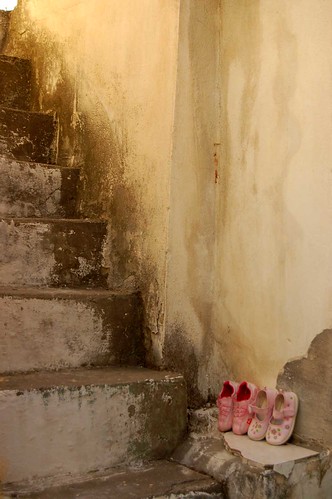and here are your future sb assignments...

Design Fundamentals
Sketchbook Assignments
Please put the week, the assignment, and the date in the lower right hand corner of each of your pages. It should look something like this: Week 5 #1 12-20-06
*all drawings should be large and fill up your entire page.
SB#5
Due: 12.20.06
Draw 9 2”x2” squares on your page. It should look like this:

Find three different objects with the different real textures. In the 1st row of squares, use line and value to create a very accurate rendering of each texture, label each square as to what it represents. In the 2nd row, simplify the texture into a pattern, using line and value. In the 3rd row, abstract the texture into pure geometric forms and lines.
Take home 8 sheets of 9x12 newsprint. Use a peeled crayon on its side to complete a series of rubbings of different textures (the technical term is “frottage” - The technique of rubbing with crayon or graphite on a piece of paper which has been placed over an object. Such impressions are usually made from such highly textured subjects as leaves, wood, wire screen, gravestones, and manhole covers). Now, in your sketchbook, divide a page into at least 8 sections, can be any size or shape (ie, they do not have to be rectangles. If you use more than 8 sections, repeat the textures – this could add more unity to your composition...) and fill up each section with a drawn representation of the frottages. You are reducing the texture rubbings into patterns. Use color to make a successful composition.
Color Wheel – use color!
Create an interesting shape to repeat and fill with primary colors (R, Y, B)
Create another shape to repeat and fill with secondary colors (O, G, V)
Create a third shape to use for tertiary colors (RO, YO, YG, BG, BV, RV)
Label the color names (Notice that primaries and secondaries have their own names, but tertiary color names are a double-name)
Plan your drawing in pencil so that it will be big on the page. OK to use object shapes -
Shapes with a related theme work best! Make it decorative! Embellish the page! OK to make the lettering part of the design! Finish with an ink outline.
SB#6
Due: 1.3.07
2 hands, in 2 different positions, on the same page. Super detailed rendering, add value and texture.
Use light pencil lines to divide your page into at least 6 different sections (any size or shape). Set up a still life, and use light pencil lines to block it in. In some of the sections, use color to complete your still life, and in the alternating sections, use only pencil to add value to your drawing.
A plant or foliage. Zoom in so that the plant fills up the entire page, don’t leave any negative space around your plant. Pay attention to all of the directions that the leaves and stems go, render it as accurately as possible. Use your pencil to portray accurate volumes and values.
A crumpled paper bad/wrapping paper/etc. Pay attention to volumes. Use accurate rendering of value to create the shapes of the wrinkled paper.
Free – must be from direct observation.
SB#7
Due: 1.10.07
Find an asymmetrical 3-D object (NOT a rubix cube). Draw it from the front. Rotate it 90° clockwise, draw it. Rotate it another 90° and draw it from the back. Rotate it another 90° and draw it. Now look at from above and draw it. So, you should have 5 completely different views of the same subject on the same page. A line drawing is sufficient for this exercise, shading is not necessary.
Use value (lights and darks) to create the illusion of form (meaning 3-D shapes). Draw your unmade bed and pay attention to all the wrinkles, folds, and volumes of the fabric.
Find two objects, one that is a “cube” and one that is a sphere. Do not use outlines to draw them, only value. Show the volumes of the form without using hard outlines. Use pencil.
Find two objects, one that is a “cone” or “pyramid” and another that is a “cylinder”. Use the same technique in #3 to draw them.
Free – must be from direct observation.



No comments:
Post a Comment